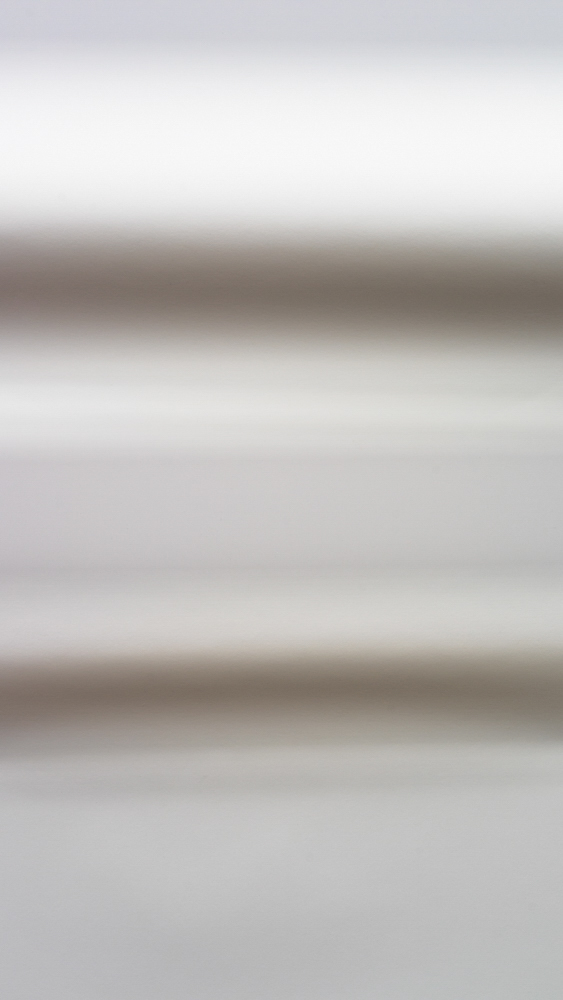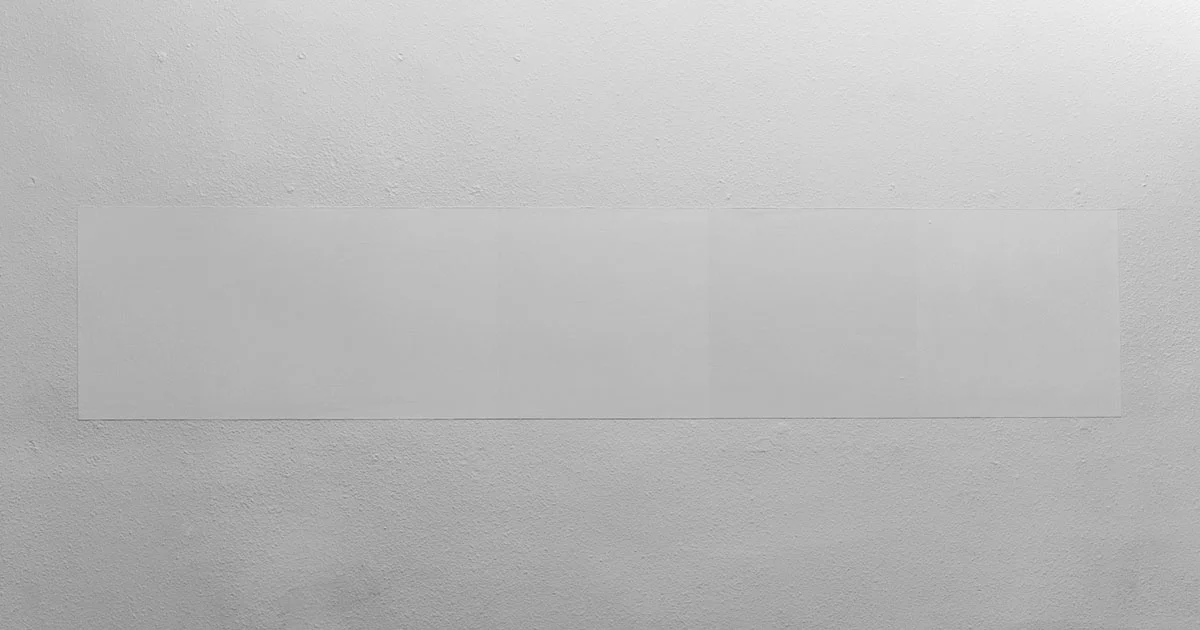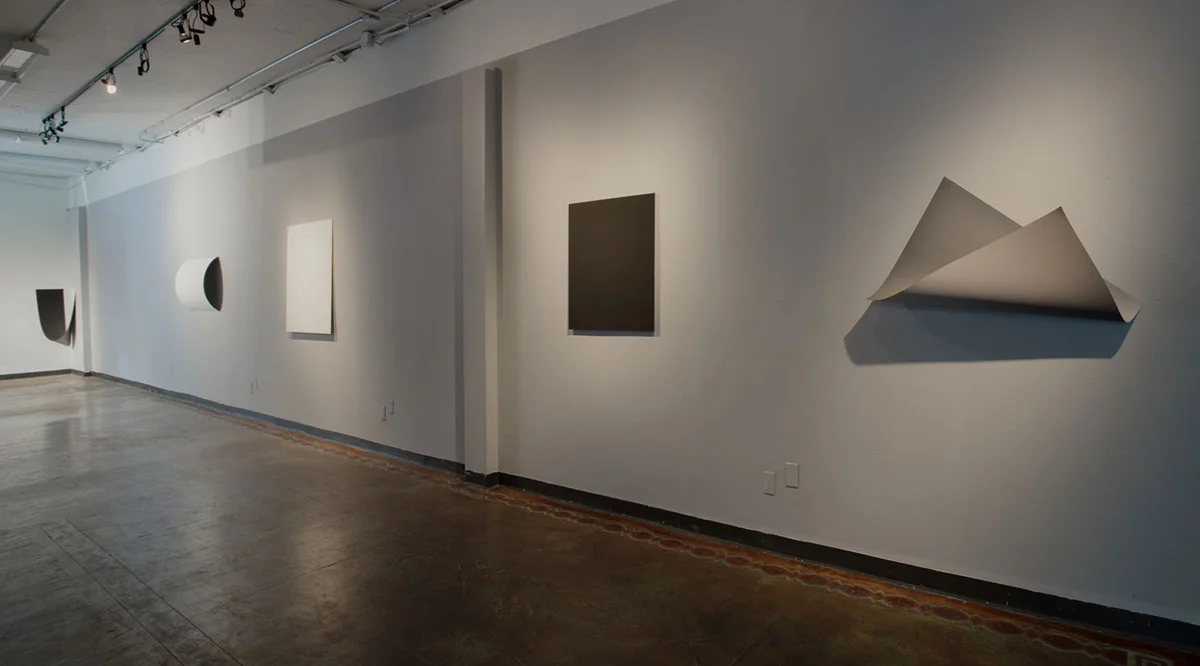Neither here nor there (000000 - ffffff) © Ariel C. Wilson
Ariel C. Wilson is a photographer and educator currently based in West Virginia. While presenting her work on the main stage at the SPE national conference in March, Wilson posed a simple but provocative question: where does the photographic image end, and the page begin?
Wilson’s series To See From Somewhere builds on the artist’s broad and overlapping interests: image materiality, or the lack of it; the role of accident or happenstance in one’s creative practice, resisting the limits imposed by representationalism, and abstraction as a means to recognize systems of inequality in and outside the art world.
After seeing Wilson speak at SPE, we spoke about her unique approach to non/image making.
Roula Seikaly in conversation with Ariel C. Wilson
Resembling shadows (Metallic Gray) © Ariel C. Wilson
Resembling shadows (Metallic Grey) -Detail © Ariel C. Wilson
Roula Seikaly: You work with esoteric aspects of photography, and I’m wondering if there are primary aesthetic or practical concerns that influence it. Could you describe them?
Ariel C. Wilson: It's transformed a lot. What I shared at SPE is my current body of work, and it’s definitely a lot quieter than previous projects. There have been a lot of conversations around minimal aesthetic, and I’m referencing minimalism directly in one of my titles with the name of the painter Agnes Martin, but there are also conversations about conceptualism happening about or around this work. What I’m most interested in is what the work is doing, not that it be categorized. I enjoy the meditative aspect of some of the things that I'm doing now. Maybe that's just what I'm needing in my life these days. I’m straying from any referent. I’m interested in what an image can be, as opposed to what it can be about.
Test Strips (After Agnes) © Ariel C. Wilson
Seikaly: This may be too on the nose, but I’m wondering if there is something that you can point to in the progression of this project that was a turning point, maybe something unexpected? Or, have you been working on this idea for a while?
Wilson: I think both. There are two moments within my work that really influenced this. The first one was a piece that I made as a part of a series called In Search of Senkito, which was based on a found journal. The last piece in the series is a silver-gelatin photograph that is exposed but undeveloped, suspended behind red, light-safe plexiglass. It's titled “His Latent Image.” That moment for me was really exciting, and it did happen really quickly. I was teaching black and white photo at the time, and I wondered why am I not even thinking about latency and the power of the potential of something to be there, but not being able to access it visually. It’s the blank space that we project ourselves onto.
So that piece happened and there was another piece that moved the work forward, which was an accident, and it was when I was photographing fog. I was trying to get away from looking at something, or rather looking through the photographic window. Fog is a magical, mysterious thing in my life that fascinates me because it doesn’t give us anything. It’s just there to look at. I was printing a photograph of fog and I accidentally laid down ink on the canvas behind the image. The effect was that the image appeared brighter than the paper as if I’d printed with white ink. It was so subtle and confusing to me. It was a total accident and was pretty transformative for me because it brought my attention to the fact that the highlights in printed photographs are transparent, that we are really seeing through the image to the paper.
His Latent Image © Ariel C. Wilson
Seikaly: I was thinking about early 19th century processes, direct printing in which the image is literally embedded in paper fiber. Revisiting that many years after my first photo history courses and thinking about your work, it reminds me how much of how much I take for granted what defines the image: the margin on the page if any, how starkly the image is set off as the focus of our attention. Looking at your work, at least in reproduction, it doesn’t provide that clear delineation of image and “not image,” and that caused a notable shift in my thinking.
Wilson: It’s such a pleasure to hear that. Thank you!
I worked in the darkroom all throughout undergrad. I didn't do any digital work until graduate school actually. I was fascinated with where edges are evident, like monotone pieces, where the image and the paper met. I've worked with some wet plate processes, and I was really attuned to the image as an object, like a metal thing that would ping when you hit it.
I lose the edges © Ariel C. Wilson
Seikaly: Exactly. That tactility is so engaging. Some of your work has a definite sculptural aspect too. I'm trying to imagine what the work looks like when it's installed and the way that it lifts away from the wall surface. I imagine them to be irresistibly enigmatic, not really giving up anything of themselves other than how they exist in space and for me, that activates a desire to lay my hands on it. I want that haptic experience to prove that these objects exist. It sets up a possible dichotomy with the non-sculptural pieces. You seem to be exploring notions of being, or not being. Could you talk about that tension?
Wilson: It’s an interesting observation. I can’t say there’s a tension for me. I was thinking about the back of the photograph, which is something we don’t often think about. Seeing how they occupy space and how paper responds to being folded and what shape the paper holds, and then how light hits the paper. Everything starts as an experiment in the studio and is then are carried through in an exhibition context. I’m also thinking about how it translates through documentation, and what the difference is between the object and the documentation of the object.
I lose the edges, I could not see to see (Installation photograph) © Ariel C. Wilson.
Seikaly: I’m thinking about curatorial concerns such as framing, mounting and wall color. Is it important for you to have a neutral color, say the general gallery white, something that the object can blend into, or do you prefer a wall color that offsets it? This goes to the dimensionality and physicality of the objects and, again, where they begin and end. How much do you think about dematerialization with this work?
Wilson: Yeah, absolutely. For a show I had in Albuquerque, To See From Somewhere, I painted one wall this universal gray. I was trying to match wall paint tone with print tone. That introduced shadows of the objects as part of the overall pieces, so dimensionality is something I’m constantly thinking about. The last show I had, I could not see to see, I only had a month to pull it together. It was really quick. I wasn't able to paint the wall gray due to the gallery’s restrictions. But, in an ideal world, yeah, I'd be able to paint the wall. With another recent piece, Reflecting the Same(Gallery Whites), I made a test strip on the wall out of drywall mud and then painted five squares with different sheens of Gallery White, from glossy to flat. I'm excited about those moments when the work extends into the space. I want the conversation to be “this is paper” and “this is wall.”
Reflecting the same (Gallery Whites) © Ariel C. Wilson
Reflecting the same (Gallery Whites) © Ariel C. Wilson
Seikaly: Here's a pivot question, if you don’t mind. I'm wondering how this project or your current visual interests affect your understanding of representational media. We live in an ever increasing media saturated world, yet this work seems to resist that saturation. Do you find yourself wanting to withdraw from it?
Wilson: Yeah, I think I’m definitely influenced by what you're talking about. I had a really influential professor at the University of New Mexico, Dr. Kirsten Buick. In her lectures, she would always say “every moment of representation is a crisis” and hearing that over and over again reminded me to think about how representation happens and who has the power to represent who. When I was starting to make this work, I was doing a lot of material tests. I was thinking about materials that have reflective or absorbent properties, like mirrors and fog.
I was thinking about what would be behind the transparent surface, and how to incorporate a photograph, such as representational image as I did with Looking at You Looking at Me. I wanted it to be a face, but whose face other than my own? Faces are not neutral. My focus was on the act of looking as opposed to the act of looking at something or someone. Even views of landscape like the images I was taking of fog imply the same colonizing viewpoint that propelled ideas of Manifest Destiny in the United States. So I’m running away from representation, and looking for something that allows me to have an experience of my body in time and space.
Alt View -Neither Here Nor There (000000 - ffffff) © Ariel C. Wilson
Seikaly: I thought this was so interesting, and I’d like to know more about it. When I read thesis statement for To See from Somewhere, I noticed that you include notes about systems of inequity and privilege that are reinforced. That goes back to what we were discussing about gallery paint colors and how neutrality and institutional authority are reinforced. I’m wondering if audiences have picked up on that. Did you include a statement in the exhibition? How have your audiences related to that, if you’ve heard about it?
Wilson: Yeah, I think I'm constantly negotiating as lots of other artists are, what aspects inform and inspire the work, and what aspects come through for the viewer, especially when it comes to abstraction. I am spending a lof of time thinking about systems of inequity and our tendency to seek visual boundaries to confirm our biases, or to define ourselves in opposition to others, but it may not come through overtly in the work. It’s the place I’m working from.
I do usually include a statement, and it generally starts with something like… “I'm really excited when I can't tell what I'm seeing.” If people leave the gallery without reassurance of what they’ve looked at, with questions in mind, that would feel good to me. I don’t think we are taught how to look at something and just describe what we see. We’ve been taught to ask what it means or what it is “about.” What’s important to me are the questions (Do i see any colors or not? Can I tell the difference between these pigments?) and the conversations about and how our perceptions are malleable, and influenced by the social structures we are subject to.
To See From Somewhere - installation view. © Ariel C. Wilson
RS: As someone who has spent a lot of time with photography and less time addressing my privilege in the wider world, your work is a great mental hip check. I’m much more accustomed to engaging matters of inequity through representational images, whether that’s race or gender or class, etc. You come at these complex matters through abstraction. I love that your work won’t allow viewers to rely on representational imagery. In effect, we accompany you as maker on your own journey of education and acknowledgement of privilege, and are challenged to do work on ourselves what we take for granted It adds, if I may, dimensionality to important and long overdue conversations.
My last question is, do you see yourself experimenting with this project long term? What does that look like for you?
ACW: I’m working on different pieces both sculpturally and digitally. One involves a Mobius strip, which I’m really excited about. How I waited so long to work on a Mobius strip is beyond me! I’ve also been making short videos that capture adjustments in Photoshop, like selective color range. One video involves moving through the highlights and the shadows of images. Another overlays a negative and a positive of the same image, creating a flat gray when they come together. I’m thinking a lot about movement, much more than I have previously, and as always, I’m fascinated with light.











